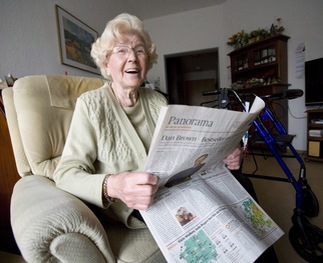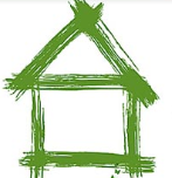
A new community model lets seniors enjoy all of the security and social amenities of a retirement community without leaving their homes. The alternative is called "aging in place." Ray Suarez reports on how this village concept may help seniors retain their independence into their golden years.
Here is the transcript from the PBS show...
RAY SUAREZ: Once a week, 82- year-old John Sears gets picked up at his Beacon Hill townhouse, and driven to a nearby grocery store. Sears looks forward to that weekly outing, and not just to replenish his pantry. His driver, Bob Spicer, works for Beacon Hill Village, a nonprofit membership organization which provides low-cost services to seniors who want to continue to live in their own homes.
JOHN SEARS: They call all the time. A couple times a week, someone will call up and say, are you still there? And if so, why? And what can we do to help you?
RAY SUAREZ: The village offers transportation to doctors and grocery stores, and provides free exercise classes and lectures on current events. It organizes social clubs like the weekly Second Cup gathering at the Beacon Hill Bistro, where members discuss books, movies and, perhaps most importantly, politics. And there's a biweekly Terrific Tuesdays happy hour where women gather at a local restaurant to plan trips to concerts and art galleries.
In short, Beacon Hill Village offers all of the amenities of a retirement community, distributed, you might say, in the dense streets of an urban neighborhood. So getting old doesn't mean leaving a cherished life behind. Instead, a senior can age in place.
When people hear about the Beacon Hill Village concept, when they learn they don't have to leave their homes, they don't have to leave everything that's familiar to them, they want to know more. And they want it for themselves. There are now 110 such villages around the United States and nearly twice that many in development.
RAY SUAREZ: Twelve years ago, Susan McWhinney-Morse and her neighbors got together to devise a way to stay in their Boston neighborhood even as their needs changed, and increased with age.
SUSAN MCWHINNEY-MORSE, Beacon Hill Village: When we initially started Beacon Hill Village, there were 11 of us who got together one cold November day with this abstract determination that, we're not going anywhere.
But we wanted to be responsible by not going anywhere. We didn't want to have to depend upon our children, who might live across the country. So, after two years, we formed this organization that seemed to fit our needs. And it was at that point we understood, began to understand that maybe we had tapped into a whole movement.
RAY SUAREZ: Beacon Hill Village now has 400 members who pay an annual fee of about $100 to $1,000, depending on their financial circumstances.
The organization has just four full-time employees and a small office space. The Village depends on donations and the work of volunteers to survive. Many of the activities take place in borrowed community spaces. Members are charged additional fees for driving and social outings. And the Village negotiates reduced prices for members to receive medical care and home repair services when needed.
When we visited John Sears, he was getting a window screen replaced.
JOHN SEARS: I have a bar for the shower and a bar for the tub that they put there and tiles fixed and bulbs inserted. Come downstairs, I have a computer. And they sent a teenager over to help get me back online. It's kind of wonderful that there are a bunch people who simply give a hoot about us old-timers around here, and that matters so much.
JOANNE COOPER: This little hut actually...
RAY SUAREZ: Is where you...
JOANNE COOPER: That's where we went down.
RAY SUAREZ: For years, Joanne Cooper, an active 78-year-old, didn't think she needed the Village because she was busy traveling. She showed me photos of her and her partner, Bill, on an archaeological dig in Israel three years ago. But Bill had a massive heart attack, and everything changed.
JOANNE COOPER: I knew that when he came home from the hospital, which was after a very brief stay, that we would need help. And so we said, it's about time. I think it's time we have to join the Village. And the Village was great.
We had a fabulous woman who would come practically every day and, when he was stronger, take him for walks, do all kinds of things.
RAY SUAREZ: Bill never recovered and died six months later. That's when Cooper discovered she needed the Village even more.
JOANNE COOPER: We had a great life, and you want to maintain that. And then you're by yourself and you have to sort of renegotiate how you're going to do things. And I started going to things at the Village.
And I began to do all the things that I did before Bill got sick, and then more.
RAY SUAREZ: The Beacon Hill Village has spawned a national organization to advise other communities.
But McWhinney-Morse says it's important for every Village to be different, tailored to the specific needs of each community. What works in an urban setting like Boston may not work in a rural town in Iowa.
SUSAN MCWHINNEY-MORSE: That's perhaps one of the geniuses in the way the village movement has been set up, because it takes into account the fact that we are all aging in different ways with different needs at different times.
People said, you cannot retire on Beacon Hill. It just won't work. You have bricks to fall on, stairs to climb, and that's not appropriate for older people. And my answer to that is that, if I stop climbing stairs, I won't be able to climb stairs.
RAY SUAREZ: And she's convinced the village concept works in neighborhoods with people of all different socioeconomic levels.
SUSAN MCWHINNEY-MORSE: We are probably a terrific answer to particularly people who are low and moderate income and middle class, who simply have no other options, who can't move to retirement communities, who don't have the resources to go to Sun City or.
RAY SUAREZ: Still, it's not easy to create a village. It takes strong leadership and commitment from residents, and a lot of money. It took an initial investment of $80,000 to start Beacon Hill Village. And, every year, the organization must raise nearly $200,000 in grants and donations to keep the operation running.
But John Sears says it's worth it. He is convinced staying in his own home is what keeps him feeling young and active.
JOHN SEARS: I love the fact that we have some kids on this little old street that, when the snow comes, they will toboggan down those cobbles that you just walked across. And they keep us a little younger and feeling that we're still part of the world.
RAY SUAREZ: Sears acknowledges not everyone will be able to stay in their own homes. Not everyone can. Mobility issues could make such a lifestyle difficult. Only 10 percent of Beacon Hill members use wheelchairs, scooters or walkers.
But he other and the other members think America should be looking at the village concept, as tens of millions of baby boomers enter their 70s and 80s in the coming years.

 RSS Feed
RSS Feed